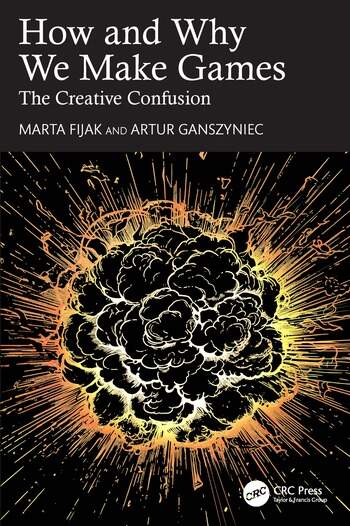By Marta Fijak, Artur Ganszyniec

Let’s delve into the intricate realms of games and their creation, and examine them through cultural, systemic, and, most notably, human lenses—explore diverse themes such as authorship, creative responsibility, the tension between games as a product and games as a form of cultural expression, and the myth of a universal audience.
The book analyzes why we should put politics in our games and how hyperrealism may be a trap. It also proposes a new framework for thinking about game narrative and a different paradigm for the production altogether. Topics tackled are approached from a multidisciplinary perspective, so be prepared to read both about Peter Paul Rubens and John Carmack. There are also graphs, system rhetorics discussions, and the market reality—stakeholders, return on investments, and the gaming bubble bursting.
This book is written for readers passionate about the craft of making games, including journalists and industry professionals. It offers a more humanistic perspective on games, presented by experienced writers who know the intricacies of game development.
Table of Contents
Click on the chapter title to see a preview.
Chapter 1: Games as a Medium.
There were a lot of video games in my youth, and they were both fascinating and mysterious. They were also a children’s thing. The parents did not understand or care for the games, and they fell into the wide category of “do not sit so long in front of the TV, go outside and play!” At least, such was my experience. But from what I gathered, many shared similar stories.
Chapter 2: Why Do People Make Games.
The question of why people make games is beyond me. At its heart, this is a question about the source of human creativity. Why are we like that? Why do we feel the need to create? Why, even when we were running after mammoths, we found the time to draw them on the walls of caves?
Chapter 3: The Myth of the Universal Audience.
Luckily for you, with a single click, you can ship the game worldwide. You just have to make it in English. This is not a big problem, as the game is text-light, and you’ve all learned English anyway. And if the game is in English, it would be able to sell on almost all markets. Who doesn’t speak English nowadays, especially if they are gamers?
Chapter 4: Traps of Realism.
Video games are, for better or worse, a visual medium and the visual side has been the driving force of technological progress in the games industry. With better hardware, better rendering techniques, higher quality models, textures, and animations, the progress curve is getting steeper every year. The assumed goal of this arms race is the perfect visual fidelity; games that would look like “reality.”
Chapter 5: Authorial Voice and Intent in System Design.
Emanations of authorial voice can be unintentional. Frankly, they mostly are, as understanding our own style and perspective comes with experience and mature auto-reflection about the process of creation. Still, even with less experienced creators, this authorial voice is present—it may be not so coherent or underdeveloped, but still, it is there. You cannot create without an authorial voice—intentional or not.
Chapter 6: The Topography of Narrative.
Let’s start with the obvious. Games tell stories. Sometimes those are convoluted epics that require a whiteboard and a dedicated fanbase to understand them fully, and sometimes they are as simple as a miraculous victory by getting that straight tetromino in a tense game of Tetris. Nonetheless, games are a storytelling medium, a unique one, as the player is a co-author of the story.
Chapter 7: Playing with Authorship.
“One obvious difference between art and games is that you can win a game. It has rules, points, objectives, and an outcome.” Ebert says. Movies and books are different. “Those are things you cannot win; you can only experience them.” Would Shakespeare’s Romeo and Juliet still be a masterpiece if the spectator could win a happy ending?
Chapter 8: Why Games Will Always Be Political.
“Get this filthy political agenda out of my games,” “It was a great game until they introduced politics into it,” “Once you go woke, you go broke,” “I hate this type of baiting on political issues.” Who of us has not seen this kind of lovely discourse online each time a game does something as radical as introducing women or more skin colors?
Chapter 9: Author as a Group Entity: How It Feels to Be One of 500 Voices.
Death Stranding, a game by Hideo Kojima, was made by around 80 people. American McGee’s Alice was made by around 90 people. Sid Meier’s SimGolf was done by around 106 people. Yet, Getting Over It with Bennett Foddy seems to have been done almost in its entirety by Bennett Foddy, but I hope that you get the point.
Chapter 10: Slow Games.
The story started a few years ago when I turned 40—a perfect moment to indulge in self-reflection. At that moment in my life, I was overworked (a burden that I personally put on myself), I was balancing on the edge of burnout (looking back, on the wrong side of the edge), and I started having some health issues—all in all, I decided that I had to slow down.
Chapter 11: Games of the End Times.
The year is 2023, November. The Israeli attack on Palestine is in full swing. The Russian-Ukrainian war is reaching its second year. The world is on track for 2.5°C of global warming by the end of the century. New wealth, created since 2020, was in two-thirds, gained by the richest 1%. Inflation has been on the rise, but wages stagnated in many places. Since the beginning of the year, 250,016 IT workers lost their jobs. More than 8000 game developers who also lost their jobs were not counted in that number.